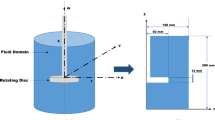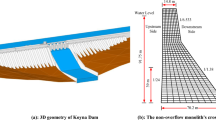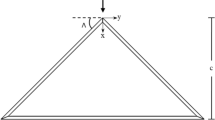Abstract
Resistance prediction of ships using computational fluid dynamics has gained popularity over the years because of its high accuracy and low cost. This paper conducts numerical estimations of the ship resistance and motion of a Japan bulk carrier model using SHIP_Motion, a Reynolds-averaged Navier–Stokes (RaNS)-based solver, and HydroSTAR, a commercial potential flow (PF)-based solver. The RaNS solver uses an overset-structured mesh and discretizes the flow field using the finite volume method, while the PF-based solver applies the three-dimensional panel method. In the calm water test, the total drag coefficient, sinkage, and trim were predicted using the RaNS solver following mesh dependency analysis, and the results were compared with the available experimental data. Next, calm water resistance was investigated for a range of Froude numbers. The added resistance in short-wave cases was simulated using both RaNS and PF solvers, and the results were compared. The PF solver showed better agreement with the RaNS solver for predicting motion responses than for predicting added resistance. While the added resistance results could not be directly validated because of the absence of experimental data, considering the previous accuracy of the RaNS solver in added resistance prediction and general added resistance profile of similar hull forms (bulk carriers), the prediction results could be concluded to be reliable.







Similar content being viewed by others
References
Akimoto H, Miyata H (2002) Finite-volume simulation method to predict the performance of sailing boat. J Mar Sci Technol 7:31–42. https://doi.org/10.1007/s007730200011
Celik IB, Ghia U, Roache PJ, Freitas CJ, Coleman H, Raad PE (2008) Procedure for estimation and reporting of uncertainty due to discretization in CFD applications. J Fluids EngTrans ASME 2008:078001. https://doi.org/10.1115/1.2960953
Chen X-B (2004) Hydrodynamics in offshore and naval applications - part I. Perth, Australia, November, 2004
Chen X-B, Rezende F (2009) Efficient computations of second-order low-frequency wave load. 28th International Conference on Ocean, Offshore and Arctic Engineering, Honolulu, 2009. OMAE2009–79522, 525–532. https://doi.org/10.1115/OMAE2009-79522
Deng GB, Queutey P, Visonneau M (2010) RANS prediction of the KVLCC2 tanker in head waves. J Hydrodyn 22(5):476–481. https://doi.org/10.1016/S1001-6058(09)60239-0
Faltinsen OM, Minsaas KJ, Liapis N, Skjørdal SO (1980) Prediction of resistance and propulsion of a ship in a seaway. In Proceedings of 13th Symposium on Naval Hydrodynamics, Monterey CA
Fuji H, Takahashi T (1975) Experimental study on the resistance increase of a ship in regular oblique waves. Proceedings of the 14th ITTC 4, Ottawa: 351–360
Gerritsma J, Beukelman W (1972) Analysis of the resistance in waves of a fast cargo ship. International Shipbuilding Progress 19(217):285–293. https://doi.org/10.3233/ISP-1972-1921701
Islam H, Akimoto H (2015) Prediction of ship resistance in head waves using RaNS based solver. International Conference on Mechanical Engineering (ICME), BUET, Dhaka, 2015. https://doi.org/10.1063/1.4958371
Islam H, Rahman MM, Islam MR, Akimoto H, Afroz L (2017) Comparative study of RaNS and PF based solver for predicting added resistance of a very large crude carrier. Procedia Eng 194:74–81. https://doi.org/10.1016/j.proeng.2017.08.119
Islam H (2015) Prediction of ship resistance in oblique waves using RaNS based solver. MS Thesis, Division of Ocean Systems Engineering, KAIST, 2015
Journee JMJ (2001) Verification and validation of ship motion program SEAWAY. Report 1213a, Shiphydrodynamics laboratory, Delft University of Technology, 2001
Kashiwagi M (2009) Impact of hull design on added resistance in waves—application of the enhanced unified theory. Proceedings of the 10th International Marine Design Conference, Trondheim, Norway. 2009. pp 521–535
Kim K-H, Kim Y (2011) Numerical study on added resistance of ships by using time-domain Rankine panel method. Ocean Eng 38:1357–1367. https://doi.org/10.1016/j.oceaneng.2011.04.008
Kim J, Park I-R, Kim K-S, Kim Y-C, Kim YS, Van S-H (2013) Numerical towing tank application to the prediction of added resistance performance of KVLCC2 in regular waves. Proceedings of the Twenty-third (2013) International Offshore and Polar Engineering (ISOPE). Anchorage, Alaska, USA, June 30–July 5, 2013. ISOPE-I-13-348
Kim H, Akimoto H, ISlam H (2015) Estimation of the hydrodynamic derivatives by RaNS simulation. Ocean Eng 108:129–139. https://doi.org/10.1016/j.oceaneng.2015.08.010
Kim M, Hizir O, Turan O, Incecik A (2017) Numerical studies on added resistance and motions of KVLCC2 in head seas for various ship speeds. Ocean Eng 140:466–476, 2015. https://doi.org/10.1016/j.oceaneng.2017.06.019
Larsson L, Stern F, Bertram V (2003) Benchmarking of computational fluid dynamics for ship flows: the Gothenburg 2000 workshop. J Ship Res 47:63–81 2003
Larsson L, Stern F, Visonneau M (2011) CFD in ship hydrodynamics- results of the Gothenburg 2010 workshop. Marine 2011, IV International Conference on Computational Methods in Marine Engineering, Computational Methods in Applied Sciences, 2011. https://doi.org/10.1007/978-94-007-6143-8_14
Maruo H (1957) The excess resistance of a ship in rough sea. Int Shipbuild Prog 4:337–345
Moctar B, Kaufmann J, Ley J, Oberhagemann J, Shigunov V, Zorn T (2010) Prediction of ship resistance and ship motions using RANSE. In: Proceedings of Gothenburg 2010: A Workshop on CFD in Ship Hydrodynamics
Ock YB (2014) Numerical simulations of added resistance around ships in regular head waves using overset grids. MS Thesis, Department of Naval Architecture and Ocean Engineering, Pusan National University, 2014 (in Korean)
Orihara H (2005) Development and application of CFD simulation technology for the performance estimation of ship in waves. PhD Thesis, Tokyo University, 2005 (in Japanese)
Orihara H, Miyata H (2003) Evaluation of added resistance in regular incident waves by computational fluid dynamics motion simulation using an overlapping grid system. J Mar Sci Technol 8:47–60. https://doi.org/10.1007/s00773-003-0163-5
Pelaez JG, Papanikolaou A, Gonzalez V (2000) Numerical and experimental study on the seakeeping performance of a fast round-bilge mono hull. Proceedings of the 4th Osaka Colloquium on Seakeeping Performance of Ships. Cosmosquare Int. Education and Training Center, Osaka, Japan
Sadat-Hosseini H, Wu P-C, Carrica PM, Kim H, Toda Y, Stern F (2013) CFD verification and validation of added resistance and motions of KVLCC2 with fixed and free surge in short and long head waves. Ocean Eng 59(2013):240–273. https://doi.org/10.1016/j.oceaneng.2012.12.016
Sadat-Hosseini H, Carrica P, Kim H, Toda Y, Stern F (2010) URANS simulation and valiation of added resistance and motions of the KVLCC2 crude carrier with fixed and free surge conditions. In: Proceedings of Gothenburg 2010: A Workshop on CFD in Ship Hydrodynamics
Seo M-G, Yang K-K, Park D-M, Kim Y (2014) Numerical analysis of added resistance of ships in short waves. Ocean Eng 87:97–110. https://doi.org/10.1016/j.oceaneng.2014.05.011
Shen Z, Wan D, Carrica PM (2015) Dynamic overset grids in OpenFOAM with application to KCS self-propulsion and maneuvering. Ocean Eng 108:287–306. https://doi.org/10.1016/j.oceaneng.2015.07.035
Shigunov V, el-Moctar O, Papanikolaou A, Potthoff R, Liu S (2018) International benchmark study on numerical simulation methods for prediction of manoeuverability of ships in waves. Ocean Eng 165:365–385. https://doi.org/10.1016/j.oceaneng.2018.07.031
Sigmund S, el Moctar O (2018) Numerical and experimental investigation of added resistance of different ship types in short and long waves. Ocean Eng 147(2018):51–67. https://doi.org/10.1016/j.oceaneng.2017.10.010
Simonsen CD, Otzen JF, Joncquez S, Stern F (2013) EFD and CFD for KCS heaving and pitching in regular head waves. J Mar Sci Technol 18:435–459. https://doi.org/10.1007/s00773-013-0219-0
Söding H, Shigunov V, Schellin TE, Moctar O (2014) A Rankine panel method for added resistance of ships in waves. ASME J Offshore Mech Arct Eng 136(3):031601-031601-7. https://doi.org/10.1115/1.4026847
Tokyo 2015 Workshop, JBC, 2015. [Online]. Available: http://www.t2015.nmri.go.jp/jbc_gc.html. Accessed 2016
Author information
Authors and Affiliations
Corresponding author
Additional information
Article Highlights
• Calm water simulations are performed for a JBC model at different Froude numbers using a RaNS solver, after verification and validation study
• Added resistance simulations are performed using both a RaNS- and PF-based solver
• The results provide initial reference data for future studies of the JBC model
Rights and permissions
About this article
Cite this article
Islam, H., Rahaman, M., Islam, M.R. et al. Application of a RaNS and PF-Based Method to Study the Resistance and Motion of a Bulk Carrier. J. Marine. Sci. Appl. 18, 271–281 (2019). https://doi.org/10.1007/s11804-019-00096-4
Received:
Accepted:
Published:
Issue Date:
DOI: https://doi.org/10.1007/s11804-019-00096-4




